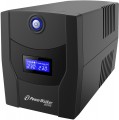Half load operating time
UPS continuous operation time from a fully charged battery when connected to a load with a power equal to half the output power of the UPS (maximum or effective, depending on the type of load, see below for details). The operating time with such a load is much longer than for a full load, and even in the simplest models it can reach 20-30 minutes.
Input voltage range
In this case, the input voltage range is implied, in which the UPS is able to supply a stable voltage to the load only due to its own regulators, without switching to the battery. For redundant UPSs (see "Type") this range is quite small, approximately 190 to 260 V; for interactive and especially inverter ones, it is much wider. Some UPS models allow you to manually set the input voltage range.
Peak output power
The maximum output power supplied by the UPS, in other words, the highest apparent load power allowed for this model.
This indicator is measured in volt-amperes (the general meaning of this unit is the same as that of the watt, and different names are used to separate different types of power). The total power consumption of the load, implied in this case, is the sum of two powers — active and reactive. Active power is actually effective power (it is indicated in watts in the characteristics of electrical appliances). Reactive power is the power wasted by coils and capacitors in AC devices; with numerous coils and/or capacitors, this power can be a fairly significant part of the total energy consumption. Note that for simple tasks, you can use data on effective power (it is often given for UPS — see below); but for accurate electrical calculations it is worth using the full one.
The simplest selection rule for this indicator is: the maximum output power of the UPS in volt-amperes should be at least 1.7 times higher than the total load power in watts. There are also more detailed calculation formulas that take into account the characteristics of different types of load; they can be found in special sources. As for specific values, the most modest modern UPSs give out
700 – 1000 VA, or even
less — this is enough to power a PC of average performance; and in the most "heavyweight" models, th
...is figure can be 8 – 10 kVA and higher.Rated output power
The effective output power of the UPS is, in fact, the maximum active power of the load that can be connected to the device.
Active power is consumed directly for the operation of the device; it is expressed in watts. In addition to it, most AC devices also consume reactive power, which is "wasted" (relatively speaking) is spent by coils and capacitors. Apparent power (denoted in volt-amperes) is precisely the sum of active and reactive power; it is this characteristic that should be used in accurate electrical calculations. See "Maximum output power" for details; here we note that when selecting a UPS for a relatively simple application, it is quite possible to use only effective power. This is at least easier than converting the watts claimed in the characteristics of the connected devices into full power volt-amps.
The most modest modern "uninterruptibles" give out
less than 500 watts.
501 – 1000 W can be considered an average value,
1.1 – 2 kW is above average, and in the most powerful models this figure
exceeds 2 kW and can reach very impressive values (up to 1000 kW or more in some industrial class UPS).
Efficiency
Efficiency (coefficient of performance) in the case of a UPS is the ratio of its output power to the power consumed from the network. This is one of the main parameters that determine the overall efficiency of the device: the higher the efficiency, the less energy the UPS wastes (due to heating parts, electromagnetic radiation, etc.). In modern models, the efficiency value can reach 99%.
Full charge time
The time it takes to fully charge the UPS battery. Note that in this case, this time is calculated according to special rules: not from 0 to 100% of the charge, but from a state in which it is impossible to maintain half the load, up to 90% of the charge. Of course, a full charge will take a little longer. However, this data is closer to practice than the “from 0 to 100%” calculation: the inability to work at half load makes the UPS practically useless, and this condition can be taken as zero, and 90% of the battery is already able to provide a good guarantee in case of a power failure.
Noise level
The maximum noise level produced by the UPS during operation. A noise of 30 dB approximately corresponds to a loud whisper, 40 dB to a conversation at a distance of several metres (it is models up to 40 dB that can be considered
quiet UPS), 50 dB is considered the maximum noise level that does not create discomfort. The redundant power supplies are the least noisy, and inverter power supplies are the noisiest (see "Type"). In general, the lower the noise level, the more comfortable the use of the UPS, however, for devices installed in offices where people do not stay permanently (for example, server rooms), this parameter is not critical.

